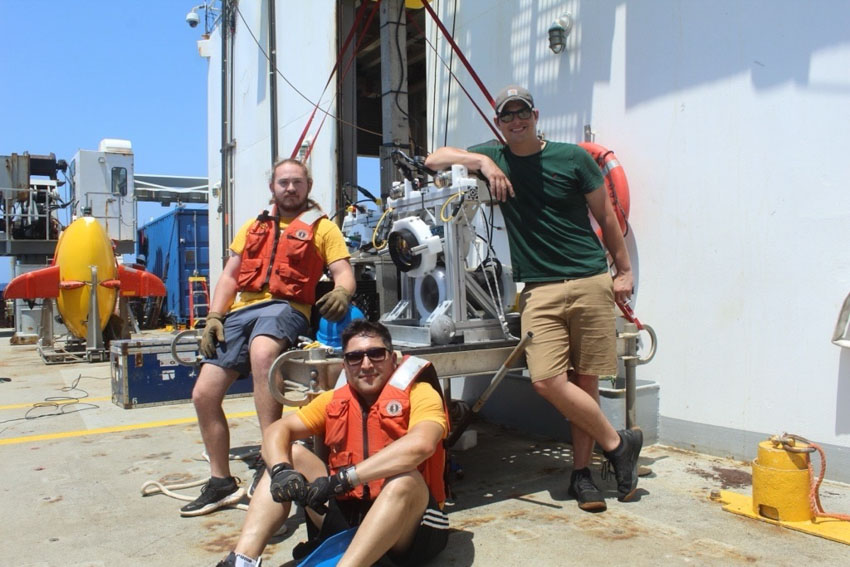Two students from the University of Southern Mississippi (USM) School of Ocean Science and Engineering (SOSE) boarded the R/V Roger Revelle to study the physics on natural hydrocarbon seeps and the physical processes that control the fate of the released oil and gas in the Gulf of Mexico. Joshua Seymour and Charles Heatherly were chosen to be part of a diverse student research group comprised of students and professors from the University of Georgia, the University of Missouri Columbia, and Southern Miss.
Seymour and Heatherly collaborated with USM SOSE professor Mahdi Razaz to build the frames required to deploy high-resolution underwater cameras in April and May 2023 and test them to ensure their deployment readiness. They boarded the vessel to Bush Hill (GC-185), a location in the Gulf of Mexico off the coast of Louisiana. The location is known for hydrocarbon seeps, where natural occurrences such as oil or natural gas escape from underneath the ocean floor and navigate to the Earth’s surface. Seymour and Heatherly deployed two cameras to measure natural gas release over the course of six months. Using special underwater flood lights, the cameras capture 4K videos (15 seconds every 3 hours) at 545 meters deep.
“It was a wonderful experience that I am sure we will all remember for the rest of our lives. Josh and I learned many things and had so much fun completing the deployment of our equipment at GC185,” said Heatherly.

The research crew observed a community of chemosynthetic organisms that rely on oil, gas, and bacteria for survival. The students were joined by Dr. Daniela Di lorio from the University of Georgia (Chief Scientist), Dr. Binbin Wang from the University of Missouri, and other doctoral students. Both Seymour and Heatherly brought a unique set of skills to the research crew with a more advanced knowledge of hands-on experience thanks to SOSE’s immersive marine educational programs.
“Charles, Mahdi, and I were able to solve many problems that arose with other groups’ equipment,” expressed Seymour. “Our experience working outside of the classroom has been enhanced by the hands-on nature of the Ocean Engineering Program here at USM. I couldn’t help but feel a sense of pride knowing that the three of us quickly became the fix-it guys.”
Razaz, Seymour, and Heatherly designed and built a Particle Tracking Velocimeter (PTV) camera for deployment. The crew used advanced underwater vehicles such as an AUV Sentry for a bathymetric survey and an ROV Jason to video seeps.
“I was very proud of Josh and Charles, as we were the most technical people in the science team, and the res-techs soon realized that they could rely on us for deploying all the instruments,” stated Razaz. “Charles controlled a very powerful winch. Josh and I led the line while fixing CTDs (sensors to measure salinity and temperature-depth) to the line. Charles and Josh made themselves available for work from 4 a.m. until sometimes 10 p.m. They volunteered for long shifts in the ROV control van, ensuring we found all the seeps and recorded all the major events and coordinates.”
The crew will return to Bush Hill at GC-185 in November to complete data collection with more scientists from Texas A&M and Woods Hole Oceanographic Institute.
“It’s a pleasure to work with tech-savvy and reliable students,” said Razaz.
Learn about how USM’s School of Ocean Science and Engineering provides a unique pathway to enhance the blue economy further and create a sustainable Gulf Coast.